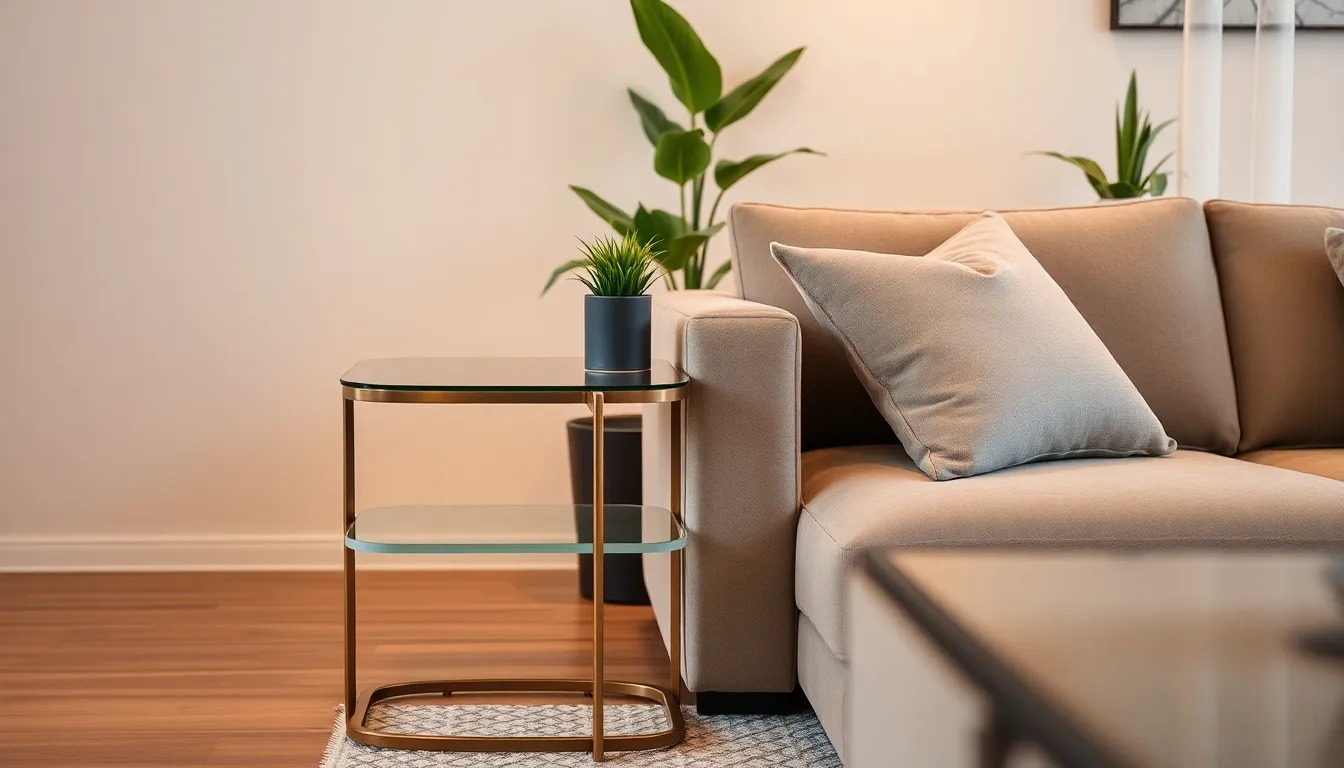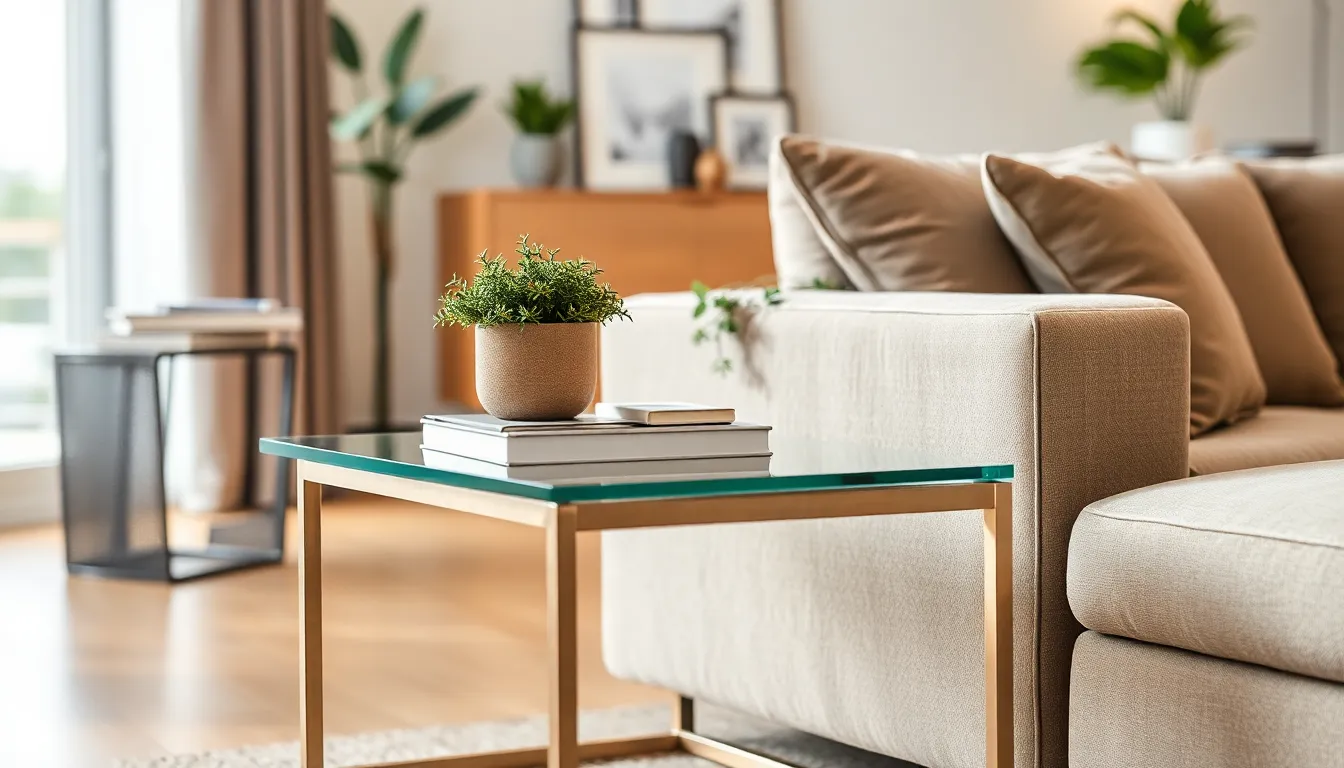Table of Contents
ToggleIn the world of living rooms, side tables are the unsung heroes. They’re not just furniture; they’re the trusty sidekicks that hold your drinks, books, and the occasional snack while you binge-watch your favorite show. Imagine a living room without a side table—chaos would reign as remote controls and half-eaten bags of chips tumble into oblivion.
Importance Of Side Tables For Living Rooms
Side tables play crucial roles in living rooms, enhancing both functionality and style. They offer convenient surfaces for placing drinks, books, or decorative items, ensuring easy access to everyday essentials. Unexpected guests can take advantage of these tables for snacks and beverages, reinforcing the hospitality of the space. Vital organization features emerge when side tables keep clutter at bay, preventing remote controls and other small items from being misplaced.
Creative design options within side tables allow for personalization, matching the room’s aesthetics. Various materials, such as wood, metal, and glass, cater to different tastes, ensuring compatibility with existing décor. Shape and size also present flexibility, accommodating various living room layouts, whether large or small.
Functionality is not limited to utility alone. Side tables can serve as focal points, drawing attention and enhancing the overall ambiance. Whether adorned with a stylish lamp or a captivating piece of art, they contribute significantly to the room’s visual appeal.
Investing in quality side tables can increase the living room’s practicality. Reinforced durability ensures these pieces withstand everyday use, providing long-lasting service. Selecting multifunctional side tables, such as those with storage capabilities, optimizes space usage, further embedding them as vital furniture components.
Regularly integrating side tables into lounge areas promotes a more inviting atmosphere. Their presence naturally encourages interaction, whether for casual conversations or leisurely activities. With clear advantages in organization, aesthetics, and function, side tables undoubtedly enhance the living room experience.
Types Of Side Tables

Side tables come in various styles to enhance both functionality and aesthetic. Understanding these types allows for informed decisions when selecting the perfect piece for a living room.
Traditional Side Tables
Traditional side tables often feature classic designs, using materials like wood and wrought iron. They tend to include ornate details, such as carved legs and decorative inlays. These tables typically offer a warm, inviting appeal that complements rustic or vintage décor. Versatile placement near sofas or armchairs serves practical purposes, providing accessibility for drinks and books. Sizes generally range from small to medium, making them adaptable for different spaces.
Modern Side Tables
Modern side tables embrace sleek lines and minimalistic designs. Material choices often include glass, metal, and engineered wood, appealing to contemporary interiors. Features like geometric shapes and bold colors create striking visual interest. Arranging these tables in open spaces encourages a sense of airiness. Sizes can vary widely, allowing for placement in both compact and spacious living rooms.
Multi-Functional Side Tables
Multi-functional side tables prioritize versatility to meet diverse needs. Many designs incorporate storage solutions, such as drawers or shelves, providing extra space for essentials. Some tables may serve dual purposes, functioning as both a side table and a small workstation or seating option. They often feature lightweight frames, making them easy to move around as needed. Ideal for smaller living room areas, these tables optimize space and organization.
Materials Used In Side Tables
Side tables come in various materials, each offering distinct advantages and aesthetics. Choosing the right material enhances both functionality and style.
Wooden Side Tables
Wooden side tables bring warmth and character to living rooms. They are available in multiple finishes like oak, walnut, and maple, allowing for personalization to match existing décor. Durability defines this material, especially with hardwood options. Many also feature intricate designs, enhancing visual appeal. Maintenance is generally minimal, with regular polishing preserving their beauty. A wooden side table stands as a timeless choice that complements both traditional and contemporary interiors.
Metal Side Tables
Metal side tables provide a sleek, modern alternative. They often include materials like aluminum, steel, and iron, offering strength combined with lightweight characteristics. Industrial designs use raw finishes that add an edgy touch. This material resists wear, making metal tables suitable for high-traffic living areas. Corrosion-resistant coatings increase longevity, making them ideal for diverse climates. Styles range from minimalist to ornate, ensuring they fit various living room themes seamlessly.
Glass Side Tables
Glass side tables create an illusion of spaciousness and are perfect for smaller living rooms. Available in tempered, frosted, and clear variations, they allow for diverse aesthetics and functionalities. Easy to clean, glass tops need little maintenance, making them convenient for daily use. Several designs pair glass with metal or wood bases, enhancing overall stability. Transparency provides versatility, harmonizing effortlessly with different furniture styles and colors. A glass side table adds a sophisticated, modern touch to any living room.
Choosing The Right Side Table
Selecting the ideal side table involves three key considerations: size and proportion, style and design, and functionality and storage.
Size And Proportion
Size plays a critical role in choosing a side table. Tables should complement the surrounding furniture without overwhelming the space. Proportion matters; selecting a table that sits at the same height as the arm of the sofa encourages easy access. For small living rooms, compact tables offer a solution without compromising on utility. Avoid oversized options in tight areas to maintain a balanced feel. Consider the space available and ensure the table fits comfortably within the layout, leaving enough room for movement.
Style And Design
Style defines the character of a side table. Various design aesthetics, from contemporary to traditional, cater to diverse preferences and decor themes. A minimalist glass table suits modern spaces, while a rustic wooden piece fits comfortably in traditional settings. Mixing different styles can also create visual interest, enhancing the overall room dynamic. Attention to detail in finishes, textures, and colors can further elevate the table’s impact, making it a statement piece or a subtle complement, depending on the desired effect.
Functionality And Storage
Functionality should align with specific needs when selecting a side table. Tables equipped with storage options can help maintain organization within the living room. Drawers or shelves provide space for remotes, books, or other essentials, reducing clutter. Multi-functional tables that serve dual roles can maximize utility, especially in small spaces. Evaluate how the table fits into daily routines, with easy access to items that enhance comfort and convenience. Focus on choosing a table that not only looks good but also meets practical requirements.
Side tables are more than just furniture; they’re essential elements that enhance both the functionality and aesthetic of living rooms. Their ability to keep everyday items organized while adding style cannot be overstated. From traditional wooden designs to sleek modern options and versatile multi-functional tables, there’s a perfect side table for every space.
Choosing the right side table involves considering size, style, and functionality to ensure it complements the living room’s overall design. Investing in a quality side table not only elevates the room’s look but also promotes a welcoming atmosphere. With the right selection, side tables can transform a living room into a more enjoyable and organized space, encouraging relaxation and social interaction.





